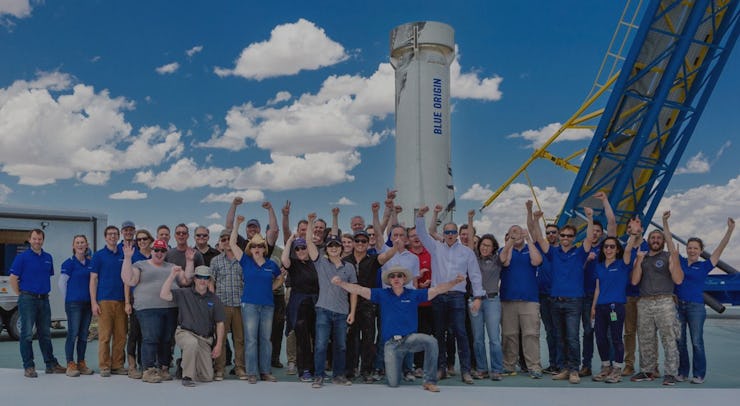Blue Origin, the aerospace company started by Amazon founder Jeff Bezos, announced on Tuesday that it would fly its New Shepard rocket for the ninth time on Wednesday morning, “pushing the rocket to its limits” and taking some employee payload with it on its brief journey, too.
Below’s the full list of what Blue Origin will send up in the rocket during the “high altitude escape motor test” that launches from the company’s West Texas launch site. Blue Origin expects to soon send people up in its rockets at a cost of about $200,000 per person for brief trips to sp
Last on the list was this inclusion: “A special addition to the Mission 9 payload manifest is a suite of payloads from Blue Origin employees as a part of our internal ‘Fly My Stuff’ program.”
“Fly My Stuff” wasn’t the idea of Bezos, though. Bigelow Aerospace had a similar program in 2006-2007 called “Fly Your Stuff,” which allowed customers of the company and others to send photos and other small items into space for a price. People sent all sorts of sentimental objects up in the Genesis II spacecraft, as the below photo shows:
Some stuff sent into space for the Bigelow Airspace "Fly Your Stuff" program in 2007.
The rocket launches at 9 a.m. Central from Texas. Similar to SpaceX launches, a webcast will begin about 20 minutes before launch at blueorigin.com.
Here’s the full list of Blue Origin payload that is going to space and back on Wednesday:
Schmitt Space Communicator Xperimental (SC1-x)
Solstar (Santa Fe, NM), developed with private funding and with support from NASA’s Flight Opportunities Program
On New Shepard Mission 8, Solstar demonstrated the first commercial WiFi in space. On this reflight, they will take advantage of the Crew Capsule’s high altitude escape and continue testing WiFi access throughout the flight.
GAGa (Granular Anisotropic Gases)
Otto-von-Guericke University (Magdeburg, Germany) with end-to-end service provider OLYMPIASPACE
(Darmstadt, Germany) and funding from German space agency, DLR
The GAGa payload investigates the statistics of granular gases, dilute collections of solid grains that interact by random collisions. Data from GAGa on New Shepard Mission 9 will help validate existing theoretical models and contribute to understanding the dynamics of related systems like avalanches and cosmic dust clouds.
Suborbital Flight Experiment Monitor-2 (SFEM-2)
NASA Johnson Space Center (Houston, TX)
SFEM-2 was first flown on Mission 8 of New Shepard, and will collect additional data on Mission 9. The experiment will record vehicle conditions including cabin pressure, temperature, CO2, acoustic conditions, and acceleration.
Condensed Droplet Experiment for NASA in Sub-Orbital Spaceflight (ConDENSS)
Purdue University (West Lafayette, IN), funded through NASA Flight Opportunities Program
ConDENSS will examine the behavior of small droplets of water in order to support the development of small and efficient heat transfer systems for spaceflight. These systems, called phase change heat transfer systems, provide more uniform surface temperatures and higher power capacities.
APL Electromagnetic Field Experiment
Johns Hopkins University Applied Physics Laboratory, funded through NASA Flight Opportunities Program
This experiment marks the first flight of the JANUS 2.1 platform with sensors to monitor magnetic fields and ambient pressure inside the vehicle. Previous versions of JANUS were flown on New Shepard Missions 6 and 7.
Vibration Isolation Platform Data Logger
Controlled Dynamics, funded through NASA Flight Opportunities Program
VIP DL is a technology demo for an active stabilization platform that aims to allow the most sensitive payloads flying on New Shepard to be isolated from ambient vibrations, allowing for even higher precision microgravity studies.
mu Space-1
mu Space Corporation (Bangkok, Thailand)
The first of Blue Origin’s New Glenn customers to purchase a slot on New Shepard, mu Space’s payload includes an assortment of scientific and medical items, several textile materials they plan to use on their future space suit and apparel, and other special articles for their community partners.
Blue Origin “Fly My Stuff”
A special addition to the Mission 9 payload manifest is a suite of payloads from Blue Origin employees as a part of our internal “Fly My Stuff” program.
The New Shepard rocket system enables payloads to spend three minutes in microgravity, and the company advertises on its “Payloads” page an “ideal” setting for “physics, gravitational biology, technology demonstrations, and educational programs.”
